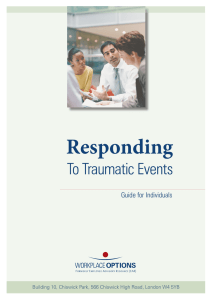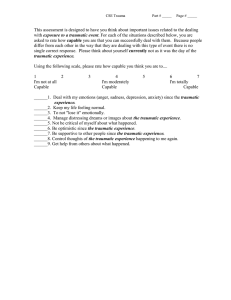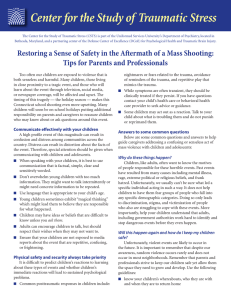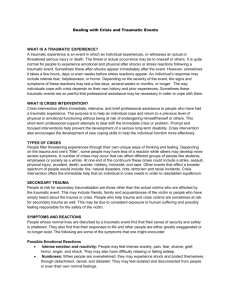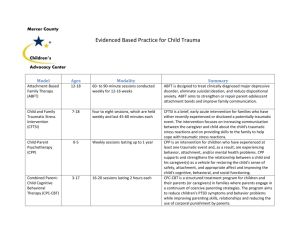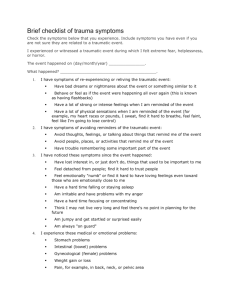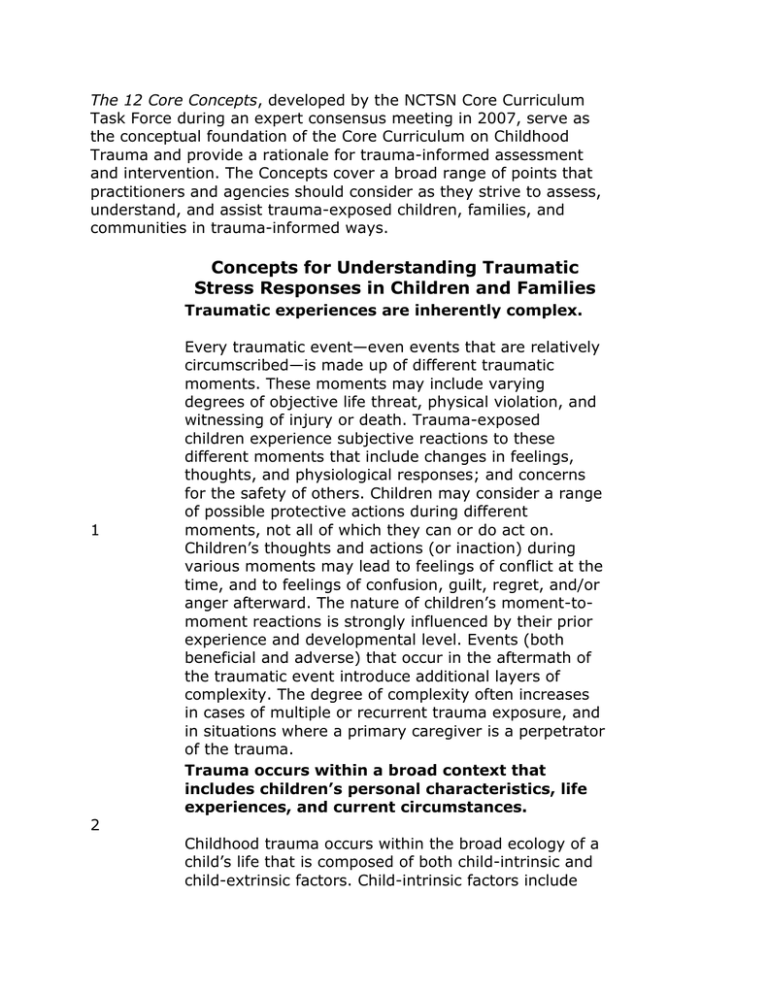
The 12 Core Concepts, developed by the NCTSN Core Curriculum
Task Force during an expert consensus meeting in 2007, serve as
the conceptual foundation of the Core Curriculum on Childhood
Trauma and provide a rationale for trauma-informed assessment
and intervention. The Concepts cover a broad range of points that
practitioners and agencies should consider as they strive to assess,
understand, and assist trauma-exposed children, families, and
communities in trauma-informed ways.
Concepts for Understanding Traumatic
Stress Responses in Children and Families
Traumatic experiences are inherently complex.
1
2
Every traumatic event—even events that are relatively
circumscribed—is made up of different traumatic
moments. These moments may include varying
degrees of objective life threat, physical violation, and
witnessing of injury or death. Trauma-exposed
children experience subjective reactions to these
different moments that include changes in feelings,
thoughts, and physiological responses; and concerns
for the safety of others. Children may consider a range
of possible protective actions during different
moments, not all of which they can or do act on.
Children’s thoughts and actions (or inaction) during
various moments may lead to feelings of conflict at the
time, and to feelings of confusion, guilt, regret, and/or
anger afterward. The nature of children’s moment-tomoment reactions is strongly influenced by their prior
experience and developmental level. Events (both
beneficial and adverse) that occur in the aftermath of
the traumatic event introduce additional layers of
complexity. The degree of complexity often increases
in cases of multiple or recurrent trauma exposure, and
in situations where a primary caregiver is a perpetrator
of the trauma.
Trauma occurs within a broad context that
includes children’s personal characteristics, life
experiences, and current circumstances.
Childhood trauma occurs within the broad ecology of a
child’s life that is composed of both child-intrinsic and
child-extrinsic factors. Child-intrinsic factors include
Concepts for Understanding Traumatic
Stress Responses in Children and Families
temperament, prior exposure to trauma, and prior
history of psychopathology. Child-extrinsic factors
include the surrounding physical, familial, community,
and cultural environments. Both child-intrinsic and
child-extrinsic factors influence children’s experience
and appraisal of traumatic events; expectations
regarding danger, protection, and safety; and course
of posttrauma adjustment. For example, both childintrinsic factors such as prior history of loss, and childextrinsic factors such as poverty may act as
vulnerability factors by exacerbating the adverse
effects of trauma on children’s adjustment.
Traumatic events often generate secondary
adversities, life changes, and distressing
reminders in children’s daily lives.
3
4
Traumatic events often generate secondary adversities
such as family separations, financial hardship,
relocations to a new residence and school, social
stigma, ongoing treatment for injuries and/or physical
rehabilitation, and legal proceedings. The cascade of
changes produced by trauma and loss can tax the
coping resources of the child, family, and broader
community. These adversities and life changes can be
sources of distress in their own right and can create
challenges to adjustment and recovery. Children’s
exposure to trauma reminders and loss reminders can
serve as additional sources of distress. Secondary
adversities, trauma reminders, and loss reminders
may produce significant fluctuations in trauma
survivors’ posttrauma emotional and behavioral
functioning.
Children can exhibit a wide range of reactions to
trauma and loss.
Trauma-exposed children can exhibit a wide range of
posttrauma reactions that vary in their nature, onset,
intensity, frequency, and duration. The pattern and
course of children’s posttrauma reactions are
influenced by the type of traumatic experience and its
consequences, child-intrinsic factors including prior
Concepts for Understanding Traumatic
Stress Responses in Children and Families
trauma or loss, and the posttrauma physical and social
environments. Posttraumatic stress and grief reactions
can develop over time into psychiatric disorders,
including posttraumatic stress disorder (PTSD),
separation anxiety, and depression. Posttraumatic
stress and grief reactions can also disrupt major
domains of child development, including attachment
relationships, peer relationships, and emotional
regulation, and can reduce children’s level of
functioning at home, at school, and in the community.
Children’s posttrauma distress reactions can also
exacerbate preexisting mental health problems
including depression and anxiety. Awareness of the
broad range of children’s potential reactions to trauma
and loss is essential to competent assessment,
accurate diagnosis, and effective intervention.
Danger and safety are core concerns in the lives
of traumatized children.
5
6
Traumatic experiences can undermine children’s sense
of protection and safety, and can magnify their
concerns about dangers to themselves and others.
Ensuring children’s physical safety is critically
important to restoring the sense of a protective shield.
However, even placing children in physically safe
circumstances may not be sufficient to alleviate their
fears or restore their disrupted sense of safety and
security. Exposure to trauma can make it more difficult
for children to distinguish between safe and unsafe
situations, and may lead to significant changes in their
own protective and risk-taking behavior. Children who
continue to live in dangerous family and/or community
circumstances may have greater difficulty recovering
from a traumatic experience.
Traumatic experiences affect the family and
broader caregiving systems.
Children are embedded within broader caregiving
systems including their families, schools, and
communities. Traumatic experiences, losses, and
ongoing danger can significantly impact these
Concepts for Understanding Traumatic
Stress Responses in Children and Families
caregiving systems, leading to serious disruptions in
caregiver-child interactions and attachment
relationships. Caregivers’ own distress and concerns
may impair their ability to support traumatized
children. In turn, children’s reduced sense of
protection and security may interfere with their ability
to respond positively to their parents’ and other
caregivers’ efforts to provide support. Traumatic
events―and their impact on children, parents, and
other caregivers―also affect the overall functioning of
schools and other community institutions. The ability
of caregiving systems to provide the types of support
that children and their families need is an important
contributor to children’s and families’ posttrauma
adjustment. Assessing and enhancing the level of
functioning of caregivers and caregiving systems are
essential to effective intervention with traumatized
youths, families, and communities.
Protective and promotive factors can reduce the
adverse impact of trauma.
7
8
Protective factors buffer the adverse effects of trauma
and its stressful aftermath, whereas promotive factors
generally enhance children’s positive adjustment
regardless of whether risk factors are present.
Promotive and protective factors may include childintrinsic factors such as high self-esteem, self-efficacy,
and possessing a repertoire of adaptive coping skills.
Promotive and protective factors may also include
child-extrinsic factors such as positive attachment with
a primary caregiver, possessing a strong social support
network, the presence of reliable adult mentors, and a
supportive school and community environment. The
presence and strength of promotive and protective
factors—both before and after traumatic events—can
enhance children’s ability to resist, or to quickly
recover (by resiliently “bouncing back”) from the
harmful effects of trauma, loss, and other adversities.
Trauma and posttrauma adversities can strongly
influence development.
Concepts for Understanding Traumatic
Stress Responses in Children and Families
Trauma and posttrauma adversities can profoundly
influence children’s acquisition of developmental
competencies and their capacity to reach important
developmental milestones in such domains as
cognitive functioning, emotional regulation, and
interpersonal relationships. Trauma exposure and its
aftermath can lead to developmental disruptions in the
form of regressive behavior, reluctance, or inability to
participate in developmentally appropriate activities,
and developmental accelerations such as leaving home
at an early age and engagement in precocious sexual
behavior. In turn, age, gender, and developmental
period are linked to risk for exposure to specific types
of trauma (e.g., sexual abuse, motor vehicle accidents,
peer suicide).
Developmental neurobiology underlies children’s
reactions to traumatic experiences.
9
10
Children’s capacities to appraise and respond to
danger are linked to an evolving neurobiology that
consists of brain structures, neurophysiological
pathways, and neuroendocrine systems. This “danger
apparatus” underlies appraisals of dangerous
situations, emotional and physical reactions, and
protective actions. Traumatic experiences evoke strong
biological responses that can persist and that can alter
the normal course of neurobiological maturation. The
neurobiological impact of traumatic experiences
depends in part on the developmental stage in which
they occur. Exposure to multiple traumatic experiences
carries a greater risk for significant neurobiological
disturbances including impairments in memory,
emotional regulation, and behavioral regulation.
Conversely, ongoing neurobiological maturation and
neural plasticity also create continuing opportunities
for recovery and adaptive developmental progression.
Culture is closely interwoven with traumatic
experiences, response, and recovery.
Culture can profoundly affect the meaning that a child
or family attributes to specific types of traumatic
Concepts for Understanding Traumatic
Stress Responses in Children and Families
events such as sexual abuse, physical abuse, and
suicide. Culture may also powerfully influence the
ways in which children and their families respond to
traumatic events including the ways in which they
experience and express distress, disclose personal
information to others, exchange support, and seek
help. A cultural group’s experiences with historical or
multigenerational trauma can also affect their
responses to trauma and loss, their world view, and
their expectations regarding the self, others, and social
institutions. Culture also strongly influences the rituals
and other ways through which children and families
grieve over and mourn their losses.
Challenges to the social contract, including legal
and ethical issues, affect trauma response and
recovery.
11
12
Traumatic experiences often constitute a major
violation of the expectations of the child, family,
community, and society regarding the primary social
roles and responsibilities of influential figures in the
child’s life. These life figures may include family
members, teachers, peers, adult mentors, and agents
of social institutions such as judges, police officers,
and child welfare workers. Children and their
caregivers frequently contend with issues involving
justice, obtaining legal redress, and seeking protection
against further harm. They are often acutely aware of
whether justice is properly served and the social
contract is upheld. The ways in which social
institutions respond to breaches of the social contract
may vary widely and often take months or years to
carry out. The perceived success or failure of these
institutional responses may exert a profound influence
on the course of children’s posttrauma adjustment,
and on their evolving beliefs, attitudes, and values
regarding family, work, and civic life.
Working with trauma-exposed children can
evoke distress in providers that makes it more
difficult for them to provide good care.
Concepts for Understanding Traumatic
Stress Responses in Children and Families
Mental healthcare providers must deal with many
personal and professional challenges as they confront
details of children’s traumatic experiences and life
adversities, witness children’s and caregivers’ distress,
and attempt to strengthen children’s and families’
belief in the social contract. Engaging in clinical work
may also evoke strong memories of personal traumaand loss-related experiences. Proper self-care is an
important part of providing quality care and of
sustaining personal and professional resources and
capacities over time.
Citation: NCTSN Core Curriculum on Childhood Trauma Task Force
(2012). The 12 core concepts: Concepts for understanding
traumatic stress responses in children and families. Core
Curriculum on Childhood Trauma. Los Angeles, CA, and Durham,
NC: UCLA-Duke University National Center for Child Traumatic
Stress.

